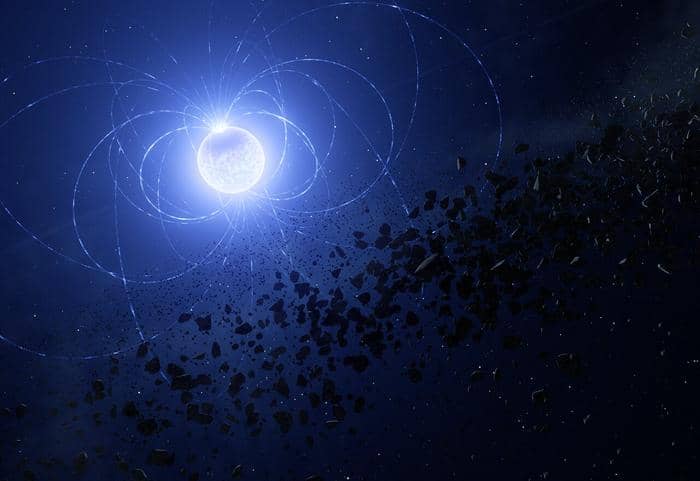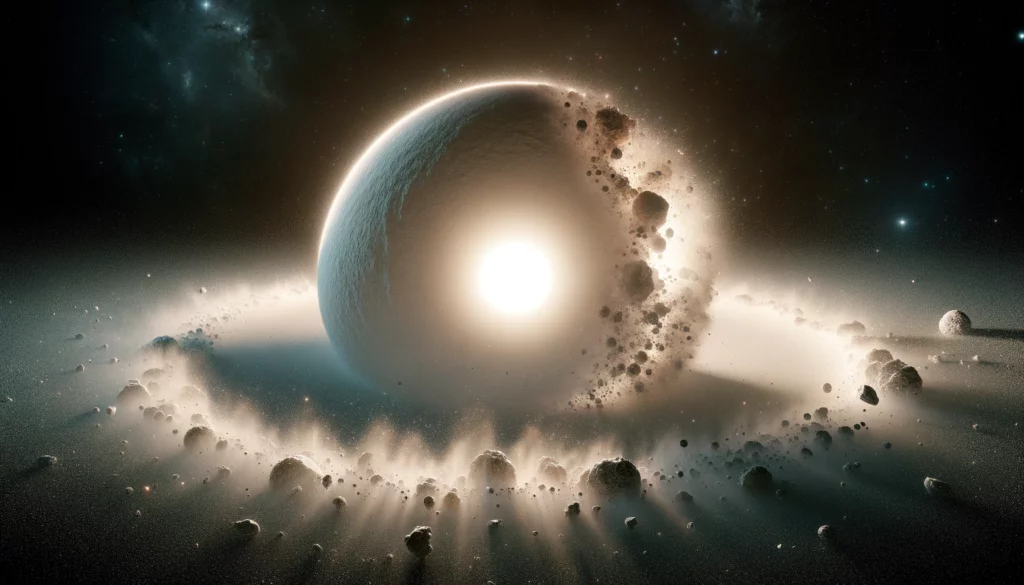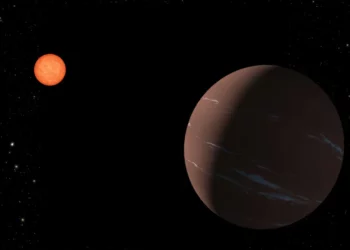Using the ESO’s Very Large Telescope, scientists have unveiled evidence of a white dwarf star’s violent past, where it has consumed planetary material, leaving a distinct scar that hints at the cosmic cannibalism taking place in the depths of space.

Hungry white dwarfs
After they exhaust the nuclear fuel in their core, some stars can become white dwarfs. They shed their outer layers, leaving behind the hot, dense, core of the star. In the process, white dwarfs can “eat” planets, particularly if a planet comes too close and is captured by the white dwarf’s strong gravitational field, leading to the planet being torn apart and its material accreted onto the white dwarf’s surface.
Now, for the first time, researchers using the European Southern Observatory’s Very Large Telescope (ESO’s VLT) in Chile, have found a signature of this process — a “scar” imprinted on the surface of a white dwarf star.
John Landstreet, a professor at Western University, Canada, who is also affiliated with the Armagh Observatory and Planetarium, has been studying white dwarfs for over 50 years — and he’s especially interested in their magnetic fields.
“A fraction of these stars show signs of having recently swallowed asteroids from their former planet-asteroid systems. We suspected that magnetic white dwarfs might show a scar where the shredded asteroid material lands on the surface, so we have been looking for signs of this as we study magnetic white dwarfs,” he told ZME Science.
Funneling asteroids
If an asteroid or a planet gets too close to a star, tidal forces start to shred it apart. Then, the heat evaporates it, says Landstree, and you end up with a cloud of atoms swirling in towards the star. Some of these atoms lose an electron and the electrons get trapped in the star’s magnetic field. It’s a bit like the auroras here on Earth — these particles are forced to follow the magnetic field towards the magnetic poles.
This is exactly what astronomers noticed on the surface of the white dwarf WD 0816-310. This white dwarf is now the Earth-sized remnant of a star that was a bit larger than our Sun. Using the telescope, astronomers have analyzed the relative numbers of various kinds of metal atoms and found that the mix of these atoms fits with the composition of primitive meteorites or rocky planets.
“It is well known that some white dwarfs — slowly cooling embers of stars like our Sun — are cannibalising pieces of their planetary systems. Now we have discovered that the star’s magnetic field plays a key role in this process, resulting in a scar on the white dwarf’s surface,” says Stefano Bagnulo, an astronomer at Armagh Observatory and Planetarium in Northern Ireland, UK, and lead author of the study.
Star scars and solar systems
The scar is essentially a concentration of metals imprinted on the surface. The “scar” composition also tells researcher what type of meal the cannibal star had.
“We have demonstrated that these metals originate from a planetary fragment as large as or possibly larger than Vesta, which is about 500 kilometres across and the second-largest asteroid in the Solar System,” says Jay Farihi, a professor at University College London, UK, and co-author on the study.
This is more than just a cool find. When a star becomes a white dwarf, it gradually cools down. It’s still hot in the beginning, but it doesn’t generate more heat, so the temperature slowly drops. Astronomers used to think that the planetary systems simply get much colder when this happens, but this process isn’t that simple.
“Now we know that such systems gradually lose their members to orbital irregularities that eventually dump much planetary mass into the dying central star,” Landstreet says.

A new way to do astronomy
Researchers want to continue monitoring the star, and they’ve even found a second candidate that may be doing similar things. This is all possible thanks to the “new way” of doing observational astronomy.
“We used to go to the desert country in northern Chile for a week or two to make our own observations. Now the observatory does the actual observing for us, and we work at home with the data they send us. Not so much time spent looking at the sky in beautiful and exotic parts of the world, but a lot less air travel, and a lot less trying to stay awake all night,” Landstreet tells ZME Science. This also facilitates international collaboration and has sped up discoveries drastically.
Landstreet should know a thing or two about how astronomy has changed. He was a member of the team that discovered the first magnetic white dwarf back in 1970. It was a time when astronomers spent all night in a cold dome beside the telescope, observing the night sky.
Landstreet has witnessed many changes in astronomy, but there’s still much to discover. The findings on WD 0816-310 not only provide a glimpse into the violent interactions that can occur in the end stages of a star’s life but also open new avenues for understanding the evolution of planetary systems around these dense remnants of stars. As white dwarfs consume material from their surroundings, they offer a unique lens through which astronomers can study the composition and dynamics of exoplanetary material.
The study was published in Astrophysical Journal Letters.






